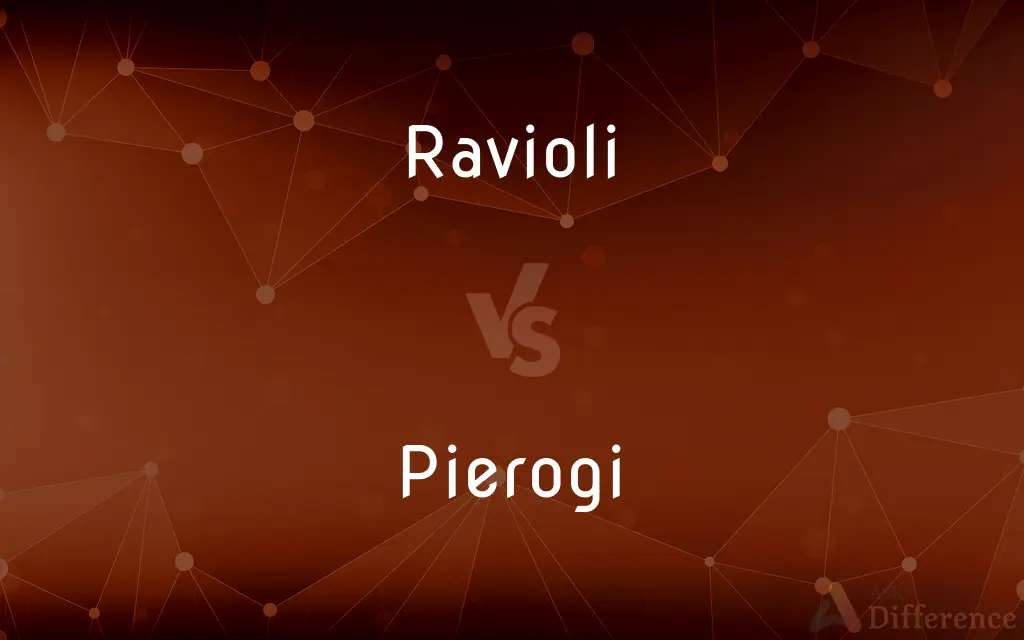Ravioli vs. Pierogi — What's the Difference?
Edited by Tayyaba Rehman — By Fiza Rafique — Updated on April 14, 2024
Ravioli, originating from Italy, typically contains cheese or meat fillings and is served with sauce; pierogi, a Polish dish, often features potato, cheese, or fruit fillings and is boiled, then fried or baked.

Difference Between Ravioli and Pierogi
Table of Contents
ADVERTISEMENT
Key Differences
Ravioli are traditional Italian pasta pockets made from egg pasta dough, commonly filled with a variety of ingredients like ricotta, meats, and vegetables. On the other hand, pierogi are Eastern European dumplings, traditionally filled with mashed potatoes, cheese, and sometimes onions or meat.
While ravioli is usually served with a sauce, such as marinara or Alfredo, pierogi are often served with toppings like sour cream, onions, or bacon bits. This reflects the differing culinary traditions and flavor profiles of Italian and Eastern European cuisines.
The preparation of ravioli involves sealing the filling between two thin layers of pasta dough. In contrast, pierogi are made by wrapping dough around the filling and sealing it with a distinctive crimped edge.
Ravioli dough is typically made with eggs, giving it a tender yet firm texture suited for boiling. Pierogi dough, on the other hand, is usually eggless, resulting in a dough that is slightly tougher and can withstand boiling as well as subsequent frying or baking.
In terms of serving occasions, ravioli can be found in both casual and upscale Italian dining, showcasing the versatility of Italian pasta dishes. Pierogi, while also versatile, are commonly associated with home cooking and traditional celebrations in Polish and other Eastern European cultures.
ADVERTISEMENT
Comparison Chart
Origin
Italy
Eastern Europe (Poland)
Typical Fillings
Ricotta, meats, vegetables
Potatoes, cheese, onions, meat
Serving Suggestion
With sauce (marinara, Alfredo)
Boiled, then fried or baked, often with sour cream or onions
Dough Composition
Includes eggs
Usually eggless
Cultural Association
Versatile in dining settings
Home cooking, festive occasions
Compare with Definitions
Ravioli
A small, sealed pasta pocket filled with cheese, meat, or vegetables.
She enjoyed a delicious dish of ravioli stuffed with spinach and ricotta.
Pierogi
A dough dumpling stuffed with a filling such as potato, cheese, or fruit.
She made pierogi filled with potato and cheddar cheese.
Ravioli
Ravioli can be homemade or bought pre-made from stores.
They bought pre-made ravioli for a quick and easy meal.
Pierogi
A staple in Eastern European cuisine, particularly Polish.
At the Polish festival, they served several varieties of pierogi.
Ravioli
A traditional Italian pasta served often in tomato or cream-based sauces.
For dinner, they served ravioli in a rich marinara sauce.
Pierogi
Can be sweet or savory, with fillings like fruits for dessert versions.
For dessert, they had sweet pierogi filled with blueberries.
Ravioli
Often considered a gourmet food depending on the filling and sauce.
The gourmet ravioli was filled with truffle and porcini mushrooms.
Pierogi
Commonly boiled, then fried or baked, often served with sour cream.
After boiling the pierogi, they fried them until golden brown.
Ravioli
A dish often featured in upscale Italian restaurants as well as everyday dining.
The menu featured lobster ravioli as a special entree.
Pierogi
Pierogi are traditionally served during festive occasions like Christmas.
They prepared pierogi as part of their traditional Christmas Eve dinner.
Ravioli
Ravioli (Italian pronunciation: [raviˈɔli]; singular: raviolo, pronounced [raviˈɔlo]) are a type of pasta comprising a filling enveloped in thin pasta dough. Usually served in broth or with a sauce, they originated as a traditional food in Italian cuisine.
Pierogi
Pierogi ( pih-ROH-ghee) are filled dumplings made by wrapping unleavened dough around a savoury or sweet filling and cooking in boiling water. They are often then pan-fried before serving.
Ravioli
Small pasta envelopes containing minced meat, fish, cheese, or vegetables, usually served with a sauce.
Pierogi
A semicircular dumpling with any of various fillings, such as finely chopped meat or vegetables, that is often sautéed after being boiled.
Ravioli
A small casing of pasta with any of various fillings, such as chopped meat or cheese.
Pierogi
(North America) A square- or crescent-shaped dumpling of unleavened dough, stuffed with sauerkraut, cheese, mashed potatoes, cabbage, onion, meat, or any combination of these, or with a fruit filling.
Ravioli
A dish made with ravioli.
Ravioli
Plural of raviolo
Ravioli
Small square parcels of pasta filled with meat, cheese, spinach etc.
Ravioli
A dish made with ravioli.
Ravioli
(informal) by analogy, similar dishes/pastas from non-Italian cuisines.
Ravioli
Small circular or square cases of dough with savory fillings
Common Curiosities
How are ravioli and pierogi made?
Ravioli are made by sealing fillings between two layers of egg pasta dough, while pierogi are formed by enclosing fillings in a single piece of dough and sealing the edges.
Are ravioli and pierogi suitable for vegetarians?
Both can be suitable for vegetarians depending on the fillings, which may include vegetables or cheeses.
Is there a traditional sauce to serve with pierogi?
While pierogi does not have a specific traditional sauce, it is commonly served with toppings like sour cream, onions, or a simple butter sauce.
What is the main difference between ravioli and pierogi?
The main difference is their origin and typical fillings; ravioli is Italian and often contains cheese or meat, while pierogi is Eastern European, often filled with potato or cheese.
What are traditional occasions for serving pierogi?
Pierogi are often associated with home cooking and special occasions in Polish and other Eastern European traditions, such as Christmas or weddings.
What types of fillings can be found in ravioli and pierogi?
Ravioli fillings often include a variety of cheeses, meats, and vegetables, whereas pierogi fillings typically feature potato, cheese, and sometimes fruit or meat.
How do the cooking methods for ravioli and pierogi differ?
Ravioli is typically boiled and served immediately, often with a sauce. Pierogi is boiled and then can be either served as is or further fried or baked.
What are some common occasions where ravioli is featured?
Ravioli is versatile and can be featured in both casual dining and special occasions, often found in Italian restaurants and home-cooked meals alike.
Are ravioli and pierogi considered healthy dishes?
Both dishes can be part of a healthy diet depending on the fillings and how they are cooked. Vegetable-filled ravioli or pierogi with light sauces can be healthier options.
Can ravioli and pierogi be served with the same sauces?
Ravioli is typically served with Italian sauces like marinara or Alfredo, whereas pierogi is usually served with toppings like sour cream or onions.
Can ravioli and pierogi be prepared in advance?
Yes, both ravioli and pierogi can be prepared in advance and frozen for later cooking, making them convenient for meal planning.
Are there any common variations in the dough recipes for ravioli and pierogi?
Ravioli dough typically includes eggs, making it rich and tender, while pierogi dough is often eggless and slightly tougher, which is ideal for boiling and frying.
How do the textures of cooked ravioli and pierogi compare?
Cooked ravioli tends to be tender and delicate due to the egg-based dough, whereas pierogi has a firmer texture, especially if it is fried after boiling.
Share Your Discovery

Previous Comparison
Bard vs. Poet
Next Comparison
Layout vs. OutlayAuthor Spotlight
Written by
Fiza RafiqueFiza Rafique is a skilled content writer at AskDifference.com, where she meticulously refines and enhances written pieces. Drawing from her vast editorial expertise, Fiza ensures clarity, accuracy, and precision in every article. Passionate about language, she continually seeks to elevate the quality of content for readers worldwide.
Edited by
Tayyaba RehmanTayyaba Rehman is a distinguished writer, currently serving as a primary contributor to askdifference.com. As a researcher in semantics and etymology, Tayyaba's passion for the complexity of languages and their distinctions has found a perfect home on the platform. Tayyaba delves into the intricacies of language, distinguishing between commonly confused words and phrases, thereby providing clarity for readers worldwide.














































